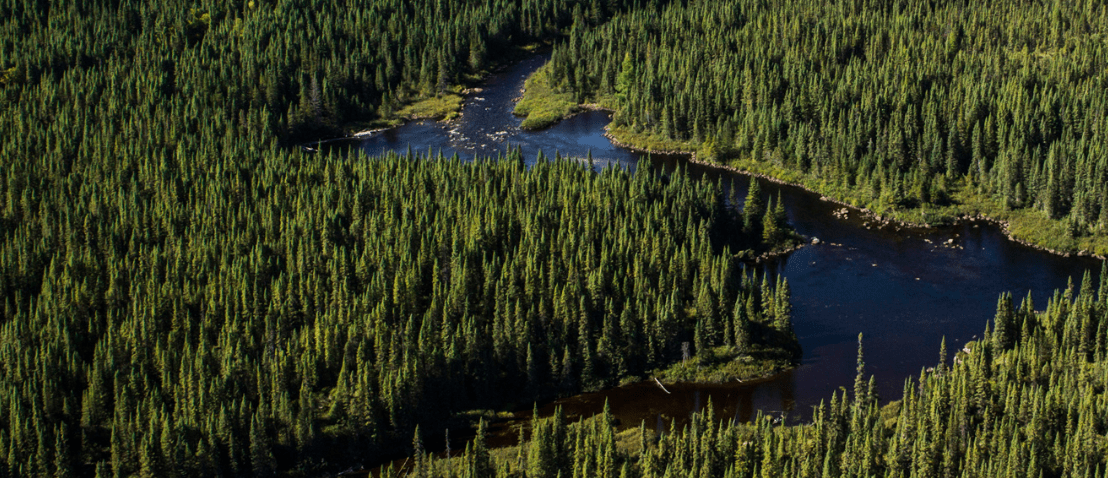Saving Canada’s Ecosystem: Importance of Native Plants for Pollinators

Looking at the state of Canada’s ecosystem, it’s clear that significant challenges are being faced. Climate change, habitat destruction, and the use of pesticides are all contributing to a decline in biodiversity. One group of organisms that is particularly vulnerable to these threats is bees, which play a vital role in the ecosystem by pollinating plants and helping to maintain the delicate balance of nature. Without bees, many plants relied on for food and other resources would disappear. This article explores the importance of native plants for bees and other pollinators, and discusses how people can work together to protect Canada’s ecosystem.
The Role of Native Plants
One way that we can help to protect bees and other pollinators is by planting native plants. Native plants are those that are naturally occurring in a particular area. They have evolved alongside the other organisms in the ecosystem and are therefore well adapted to the local conditions. When we plant native plants, we are providing bees with the food and shelter they need to survive. In addition, native plants are often more resilient to pests and diseases, which means that they require less pesticide use.
Choosing Native Plants
When selecting native plants to plant in your garden or other outdoor space, it’s important to choose plants that are well suited to the local climate and soil conditions. Here are some additional facts and tips to help you choose the right plants:
- Look for plants that are known to attract bees and other pollinators. Some good choices for Canadian gardens include wild bergamot, goldenrod, and butterfly weed.
- Choose a variety of plants that bloom at different times throughout the growing season. This will ensure that bees and other pollinators have a steady supply of food throughout the year.
- Consider planting a mix of annuals and perennials. Annuals provide a burst of color and are great for attracting pollinators in the short term, while perennials provide a more consistent source of food over the long term.
- Select plants that are well suited to the local climate and soil conditions. Native plants are adapted to the local environment and are often more resilient to pests and diseases.
- Avoid planting invasive species. Invasive species can outcompete native plants and disrupt the local ecosystem.
- Plant a variety of plant types, including trees, shrubs, and groundcovers. This will provide bees and other pollinators with a variety of habitats and nesting sites.
- Consider planting a mix of flowering and non-flowering plants. Non-flowering plants like ferns and grasses can provide important habitat and nesting sites for bees and other pollinators.
By following these tips, you can create a diverse and healthy ecosystem that supports bees and other pollinators. Planting native plants is an important step in protecting Canada’s ecosystem and ensuring the health of our environment for generations to come.
Creating a Pollinator-Friendly Garden
If you want to help protect bees and other pollinators, consider creating a pollinator-friendly garden. To do this, you’ll need to select the right plants and create a habitat that is attractive to bees. Start by choosing a sunny location that is protected from strong winds. Then, choose a variety of native plants that bloom at different times throughout the growing season. Finally, provide bees with a source of water, such as a bird bath or a shallow dish of water with rocks in it.
Native Plants and Their Benefits
Native plants are not only beneficial for bees, but also for the environment as a whole. They help to reduce erosion, conserve water, and improve soil quality. Moreover, native plants are more resistant to pests and diseases, which means that they require less maintenance and less use of harmful chemicals. By planting native plants, we are also supporting the local ecosystem by providing habitats for other native wildlife, including birds and butterflies.
One of the most important benefits of planting native plants is that they help to promote biodiversity. When we plant a variety of native plants, we create a diverse ecosystem that can support a wide range of wildlife. This is important because biodiversity is essential for the health of the ecosystem. When a particular species of plant or animal is lost, it can have far-reaching consequences for the rest of the ecosystem. By promoting biodiversity through the planting of native plants, we can help to ensure the long-term health of our environment.
In addition to promoting biodiversity, native plants also have a positive impact on the local economy. Many native plants have cultural and economic value, as they are used in traditional medicine, for food and other resources. By planting and preserving native plants, we are supporting local industries and communities.
The Importance of Education
While planting native plants is an important step in protecting the ecosystem, it’s also important to educate the public about the importance of bees and other pollinators. Many people are unaware of the vital role that bees play in maintaining the health of the ecosystem, and they may not understand the consequences of their actions, such as using pesticides or destroying natural habitats.
Education is key to raising awareness about the importance of protecting bees and other pollinators. This can be done through a variety of means, including school programs, community outreach, and public awareness campaigns. By educating the public about the importance of bees and other pollinators, we can help to create a culture of environmental stewardship and promote a more sustainable future.
Bee Population and Conservation in Canada
Bees are among the most important pollinators in the world. They are responsible for pollinating a wide variety of plants, including many of the crops that we rely on for food. Without bees, these plants would not be able to reproduce, and the consequences would be dire. In addition to providing us with food, bees also play a critical role in maintaining the health of our ecosystems. By pollinating plants, bees help to create habitats for other organisms, and they also help to maintain the balance of the ecosystem.
The Threats Facing Bees
Unfortunately, bees are facing a number of threats that are putting their survival at risk. One of the biggest threats facing bees is habitat loss. As we continue to develop land for human use, we are destroying the natural habitats that bees rely on for food and shelter. In addition, the use of pesticides and other chemicals is also harming bees. Pesticides can kill bees directly, and they can also reduce the availability of food by killing the plants that bees rely on. Finally, climate change is also a threat to bees. As temperatures rise, it becomes more difficult for bees to find the food and shelter they need to survive.
Bees are an essential part of the ecosystem and play a crucial role in agriculture by pollinating crops. However, the bee population has been in decline in Canada. In this article, we will look at the bee population and conservation efforts in Canada.
Overview of Bee Species in Canada
There are over 800 species of bees in Canada. The most well-known species is the honey bee, which is not native to Canada but is widely used for commercial purposes.
Honey Bee Population Statistics
According to the Canadian Honey Council, the honey bee population in Canada has been declining by an average of 30% per year since 2007. This decline is due to factors such as climate change, habitat loss, pesticide use, and disease.
Are Bees Endangered in Canada?
While some bee species in Canada are endangered, the honey bee is not considered endangered. However, their population decline is a cause for concern as they play a vital role in agriculture.
Conservation Efforts in Canada
There are several organizations in Canada dedicated to bee conservation, such as Bee City Canada and the Canadian Wildlife Federation.
- Government Initiatives to Protect Bee Habitats
The Canadian government has implemented initiatives to protect bee habitats, such as planting pollinator-friendly plants in public areas and providing funding for research on bee health.
- Bee-Friendly Gardening Practices in Canada
Bee City Canada provides resources on bee-friendly gardening practices in Canada, such as planting native flowers and avoiding pesticide use.
- Toronto Bees and Their Conservation Efforts
Toronto has implemented several initiatives to protect bees, such as allowing beekeeping in the city and planting pollinator-friendly plants in public spaces.
- Honey Bee Charities in Canada
There are several honey bee charities in Canada, such as the University of Guelph’s Bees Matter campaign, which raises awareness about the importance of bees and their decline.
Bee-Friendly Flower Seeds
Planting bee-friendly flowers is an essential way to help support the bee population. These flowers provide bees with nectar and pollen, which they need to survive.
- Free Seeds for Bees and How to Save Them
Several campaigns and organizations offer free seeds for bee-friendly flowers in Canada.
- Overview of the Bees Matter Campaign
The Bees Matter campaign provides free seeds for wildflowers that are bee-friendly.
- Overview of the Précieuses Abeilles Campaign
The Précieuses Abeilles campaign provides free seeds for flowers that are native to Quebec and support local bee populations.
- Overview of the Bring Back the Bees Campaign
The Bring Back the Bees campaign by Cheerios Canada provides free seeds for wildflowers that support bee populations.
- Cheerios Canada’s Free Seeds Campaign
Cheerios Canada also provides free wildflower seeds to Canadians, with the goal of planting 100 million wildflowers by 2020.
- Other Sources of Free Wildflower Seeds for Bees
Seeds of Diversity Canada offers a seed library for members to borrow seeds, including bee-friendly flower seeds.
Bee-Friendly Flower Seed Options
Several companies offer bee-friendly flower seed mixes, such as West Coast Seeds and Veseys Seeds.
- Wildflower Seed Options
Wildflowers are an excellent option for bee-friendly gardening, and several companies, such as Stokes Seeds and McKenzie Seeds, offer wildflower seed options.
- Honey Bee Flower Seed Options
Several companies, such as Botanus and Vesey’s Seeds, offer flower seed options that specifically attract honey bees.
Honey Bees and Their Gardens
Gardens provide honey bees with a source of food and shelter. Honey bees need a diverse range of flowers to collect nectar and pollen from, and gardens can provide a variety of flower species in a concentrated area.
How to help honey bees with your garden? There are several ways to make your garden bee-friendly and help support honey bee populations.
- Bee-Friendly Flowers for Ontario Gardens
Bee City Canada provides a list of bee-friendly flowers for Ontario gardens, including black-eyed susans, asters, and coneflowers.
- Bulk Wildflower Seed Options for Bee Gardens
Bulk seed options are a cost-effective way to plant a large area with bee-friendly flowers. Seeds of Diversity Canada offers bulk wildflower seed options for members.
- Bee Garden Seed Options
Several companies offer bee garden seed options, such as the Honey Nut Cheerios Bring Back the Bees seed kit and Veseys Seeds’ Bee Garden Kit.
- Honey Bee Flower Seed Options
Several companies offer flower seed options that specifically attract honey bees, such as Botanus and Vesey’s Seeds.
Collaboration is Key
Bees and other pollinators play a vital role in maintaining the health of Canada’s ecosystem. However, they are facing significant threats from habitat loss, pesticide use, and climate change. By planting native plants and creating pollinator-friendly habitats, we can provide bees with the food and shelter they need to survive. In addition, promoting education about the importance of bees and other pollinators can help to create a culture of environmental stewardship and promote a more sustainable future.
Protecting Canada’s ecosystem is an urgent task that requires a collaborative effort from all of us. Governments, businesses, and individuals must work together to promote sustainable practices and protect the environment. By planting native plants, creating pollinator-friendly habitats, and promoting education about the importance of bees and other pollinators, we can take concrete steps towards protecting Canada’s ecosystem for future generations.
